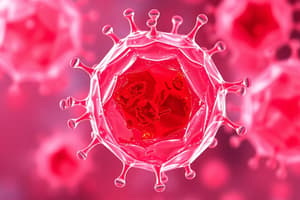Podcast
Questions and Answers
Which of the following best describes hypoxia?
Which of the following best describes hypoxia?
- A condition caused by an inadequate blood supply to an organ
- A condition caused by an excess of oxygen in the tissues
- A condition caused by a buildup of carbon dioxide in the bloodstream
- A condition caused by a reduced oxygen delivery to the tissues (correct)
What is the primary source of energy production in cells?
What is the primary source of energy production in cells?
- Fermentation
- Oxidative phosphorylation (correct)
- Krebs cycle
- Glycolysis
Which of the following is a consequence of hypoxia?
Which of the following is a consequence of hypoxia?
- Activation of the Ca2+ pump
- Increased ATP production
- Elevated intracellular pH
- Cell swelling (correct)
What is the effect of reduced oxygen levels on oxidative phosphorylation?
What is the effect of reduced oxygen levels on oxidative phosphorylation?
What is the primary cause of metabolic acidosis in hypoxia?
What is the primary cause of metabolic acidosis in hypoxia?
Which of the following is NOT a consequence of hypoxia?
Which of the following is NOT a consequence of hypoxia?
What is the effect of hypoxia on oxidative phosphorylation?
What is the effect of hypoxia on oxidative phosphorylation?
What is the primary cause of cellular swelling in hypoxia?
What is the primary cause of cellular swelling in hypoxia?
Which of the following is a consequence of increased lactic acid in cells during anaerobic respiration?
Which of the following is a consequence of increased lactic acid in cells during anaerobic respiration?
Which of the following is NOT an example of a free radical?
Which of the following is NOT an example of a free radical?
What happens to free radicals in normal conditions?
What happens to free radicals in normal conditions?
What is the primary function of glutathione in dealing with free radicals?
What is the primary function of glutathione in dealing with free radicals?
Which of the following is a consequence of excessive production or inadequate removal of free radicals in cells?
Which of the following is a consequence of excessive production or inadequate removal of free radicals in cells?
What is the effect of cell injury resulting from excessive production or inadequate removal of free radicals?
What is the effect of cell injury resulting from excessive production or inadequate removal of free radicals?
Which of the following best describes direct-acting toxins?
Which of the following best describes direct-acting toxins?
Which of the following is an example of latent toxins?
Which of the following is an example of latent toxins?
What is the primary mechanism of cell injury caused by latent toxins?
What is the primary mechanism of cell injury caused by latent toxins?
Which of the following is a common result of radiation?
Which of the following is a common result of radiation?
What happens if the damage to DNA caused by radiation is too great to be repaired successfully?
What happens if the damage to DNA caused by radiation is too great to be repaired successfully?
Which of the following is a mechanism by which cells become injured in autoimmunity and infection?
Which of the following is a mechanism by which cells become injured in autoimmunity and infection?
What is the process by which inflammatory cells generate ROS?
What is the process by which inflammatory cells generate ROS?
Which cellular components can be damaged by ROS, resulting in cell injury?
Which cellular components can be damaged by ROS, resulting in cell injury?
Which type of cell death is characterized by an inflammatory response?
Which type of cell death is characterized by an inflammatory response?
Which type of cell death is energy-dependent and does not elicit an inflammatory response?
Which type of cell death is energy-dependent and does not elicit an inflammatory response?
Which type of cell death is a normal physiological process as well as a response to injury?
Which type of cell death is a normal physiological process as well as a response to injury?
Which of the following is a characteristic feature of necrosis?
Which of the following is a characteristic feature of necrosis?
Which nuclear change is characterized by the rupture of the pyknotic nuclear membrane and fragmentation of the nucleus?
Which nuclear change is characterized by the rupture of the pyknotic nuclear membrane and fragmentation of the nucleus?
Which nuclear change is characterized by the fading of the nucleus and dissolution of chromatin due to the action of DNAases and RNAases?
Which nuclear change is characterized by the fading of the nucleus and dissolution of chromatin due to the action of DNAases and RNAases?
Which nuclear change is characterized by nuclear shrinkage and condensation of DNA into a shrunken basophilic mass?
Which nuclear change is characterized by nuclear shrinkage and condensation of DNA into a shrunken basophilic mass?
Which of the following is NOT a characteristic feature of apoptosis?
Which of the following is NOT a characteristic feature of apoptosis?
Which type of cell death is characterized by adjacent inflammation?
Which type of cell death is characterized by adjacent inflammation?
Which of the following is a characteristic feature of apoptosis?
Which of the following is a characteristic feature of apoptosis?
What is the primary role of apoptosis?
What is the primary role of apoptosis?
Which of the following is a characteristic feature of necrosis?
Which of the following is a characteristic feature of necrosis?
Which of the following is a consequence of excessive production or inadequate removal of free radicals in cells?
Which of the following is a consequence of excessive production or inadequate removal of free radicals in cells?
What is the primary cause of infarction?
What is the primary cause of infarction?
Which of the following is a consequence of ischaemia?
Which of the following is a consequence of ischaemia?
Flashcards are hidden until you start studying





